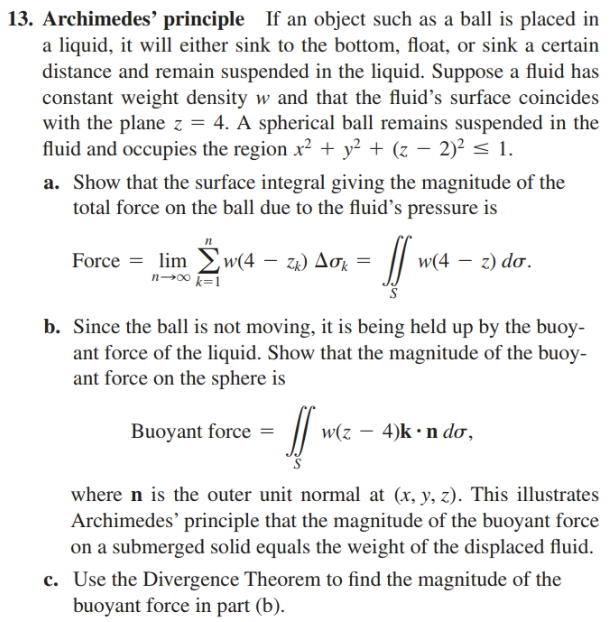13. Archimedes' principle If an object such as a ball is placed in a liquid, it will either sink to the bottom, float, or sink a certain distance and remain suspended in the liquid. Suppose a fluid has constant weight density w and that the fluid's surface coincides with the plane z = 4. A spherical ball remains suspended in the fluid and occupies the region x² + y² + (z – 2)² < 1. a. Show that the surface integral giving the magnitude of the total force on the ball due to the fluid's pressure is п Force = lim w(4 – za) Aok = n00 k=1 za) Δσ w(4 – z) do. b. Since the ball is not moving, it is being held up by the buoy- ant force of the liquid. Show that the magnitude of the buoy- ant force on the sphere is Buoyant force = w(z – 4)k •n doơ, where n is the outer unit normal at (x, y, z). This illustrates Archimedes' principle that the magnitude of the buoyant force on a submerged solid equals the weight of the displaced fluid. c. Use the Divergence Theorem to find the magnitude of the buoyant force in part (b).
13. Archimedes' principle If an object such as a ball is placed in a liquid, it will either sink to the bottom, float, or sink a certain distance and remain suspended in the liquid. Suppose a fluid has constant weight density w and that the fluid's surface coincides with the plane z = 4. A spherical ball remains suspended in the fluid and occupies the region x² + y² + (z – 2)² < 1. a. Show that the surface integral giving the magnitude of the total force on the ball due to the fluid's pressure is п Force = lim w(4 – za) Aok = n00 k=1 za) Δσ w(4 – z) do. b. Since the ball is not moving, it is being held up by the buoy- ant force of the liquid. Show that the magnitude of the buoy- ant force on the sphere is Buoyant force = w(z – 4)k •n doơ, where n is the outer unit normal at (x, y, z). This illustrates Archimedes' principle that the magnitude of the buoyant force on a submerged solid equals the weight of the displaced fluid. c. Use the Divergence Theorem to find the magnitude of the buoyant force in part (b).
Algebra & Trigonometry with Analytic Geometry
13th Edition
ISBN:9781133382119
Author:Swokowski
Publisher:Swokowski
Chapter9: Systems Of Equations And Inequalities
Section: Chapter Questions
Problem 12T
Related questions
Question

Transcribed Image Text:13. Archimedes' principle If an object such as a ball is placed in
a liquid, it will either sink to the bottom, float, or sink a certain
distance and remain suspended in the liquid. Suppose a fluid has
constant weight density w and that the fluid's surface coincides
with the plane z = 4. A spherical ball remains suspended in the
fluid and occupies the region x² + y² + (z – 2)² < 1.
a. Show that the surface integral giving the magnitude of the
total force on the ball due to the fluid's pressure is
п
Force = lim w(4 – za) Aok =
n00 k=1
za) Δσ
w(4 – z) do.
b. Since the ball is not moving, it is being held up by the buoy-
ant force of the liquid. Show that the magnitude of the buoy-
ant force on the sphere is
Buoyant force =
w(z – 4)k •n doơ,
where n is the outer unit normal at (x, y, z). This illustrates
Archimedes' principle that the magnitude of the buoyant force
on a submerged solid equals the weight of the displaced fluid.
c. Use the Divergence Theorem to find the magnitude of the
buoyant force in part (b).
Expert Solution
This question has been solved!
Explore an expertly crafted, step-by-step solution for a thorough understanding of key concepts.
This is a popular solution!
Trending now
This is a popular solution!
Step by step
Solved in 7 steps with 7 images

Recommended textbooks for you

Algebra & Trigonometry with Analytic Geometry
Algebra
ISBN:
9781133382119
Author:
Swokowski
Publisher:
Cengage

Algebra & Trigonometry with Analytic Geometry
Algebra
ISBN:
9781133382119
Author:
Swokowski
Publisher:
Cengage